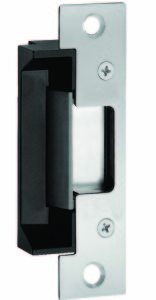 The most popular way to electrify an opening for access control remains the electric strike, but is it the best way?
The most popular way to electrify an opening for access control remains the electric strike, but is it the best way?
Electric Strikes in Fire-Rated Openings
For stairwell openings that must be unlocked in the event of a fire yet positively latched, the answer is simple: one must use an electric lock (or exit device trim) because there is no fail safe, fire-rated electric strike.
Technically, neither electric locks nor electric strikes can be field installed in fire-rated openings because fire-rated doors and frames are only supposed to be modified in a fire-rated shop. Therefore it’s a good idea to check with your Authority Having Jurisdiction (AHJ) before field installing an electric lock in one. While I have never heard of a Fire Marshal or Building Inspector enforcing this, it never hurts to be on the good side of your AHJ.
Electric Strikes vs. Electric Locks – Pros & Cons
Electric Strikes – Faster Install
Aside from fire-rated openings, why would one choose an electric strike over an electric lock or vice-versa?
Electric strikes offer the fastest install when the door frame is not filled with concrete; although, it is no fun dealing with the wiring on the hinge side for an electric lock when you have a grouted frame, either. Still, the best work-around may be to run conduit up the frame (or down the wall) to the top of the door and then use an armored cable to get the wire into the door.
Electric Locks – The Security Advantage
Electric locks also have a slight security edge over electric strikes, particularly with cylindrical locks on doors that swing out of the secured space. With an electric strike the latch is much more exposed than with an electric lock, making it a tempting target for tampering. This is also true of mortise locks, but since mortise locks have a much more robust deadlocking feature it is not as much of an issue.
On doors with rim exit devices, the latch is protected by the stop on the door frame, so the electric strike is much less vulnerable than with cylindrical or mortise lock applications. It is also less noisy than electric latch retraction.
Electric Strikes – Easier on the Wallet & Increased Versatility
Electric strikes offer lower price and easier installation, and unlike most electric locks they can be used with automatic door openers for accessibility to comply with the American Disabilities Act. Electric strikes definitely have their place in our industry. As in all hardware choices, the choice between an electric lock and an electric strike depends upon your application.

Great article Tom. Now with that said would there be a recommendation as to which electronic lock works best? I have worked with many from the big company with not a lot of success with the product.
Hi Eric-Thanks for the comment! Tom is out on vacation, but our resident locksmith and technical guru Ian Greene chimed in with:
As far as electronic locks for stand alone access control, Alarm Lock’s Trilogy have been both reliable and versatile for our customer’s needs.
In regard to electric strikes we’ve worked with HES for many years and recently have begun using Dorma electric strikes as well.
The product lines offer products that meet both the needs for aestheticism and functionality. In many cases the strikes are easier to install than some of the other brands, due to reduced cutting of frames and greater compatibility with other electrified hardware that may be being used.